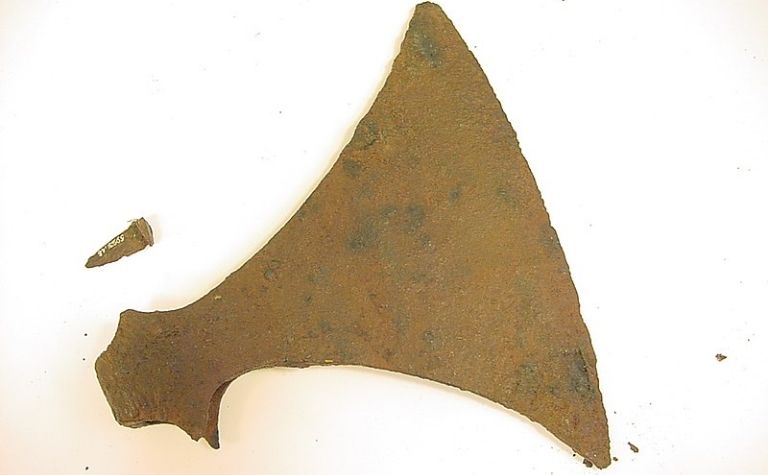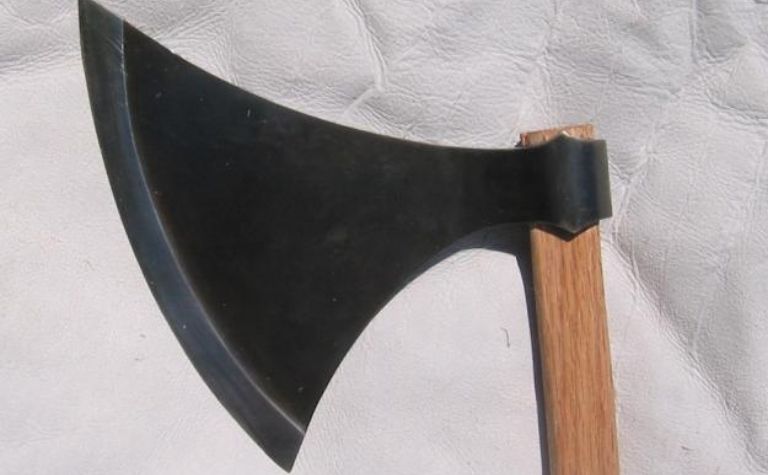When people picture a Viking, they probably imagine a heavily armored fierce warrior wielding an axe. The Vikings used several kinds of axes as tools and weapons, and the most common was the Dane axe (also called the Danish axe).
Dane axes are notable for their triangular blades with curved edges. They have long handles, and warriors wielded them with two hands. Dane axes can be very sharp and make deadly weapons.
This article will take a closer look at this iconic weapon and answer four of the most common questions about them.
Also see Norsemen vs Vikings: What’s the Difference? to learn more.

How Big Is a Dane Axe?
Axes vary in size, from one-handed hatchets to battle-axes held with both hands. Dane axes are on the larger side of the spectrum. Evidence for the size of Viking Age Dane axes comes from archaeological studies and artwork depicting Viking warriors.
A Dane axe has a blade that’s about 22 centimeters (8 inches) long and a shaft about a meter (39 inches) long. Despite being a two-handed weapon, Dane axes are relatively light and easy to wield.
The blade of a Dane axe is very thin, making it both sharp and lightweight. The heel, or lower corner, of the blade, is often not as pronounced as the toe, or upper corner, giving the blade an asymmetrical shape. This shape is useful for cutting as well as hooking onto an opponent’s shield and grappling.
Because the shafts were made with wood, there are no surviving Dane axe handles from the Viking Age. Using centuries-old artwork and the size of the axe heads, The National Museum of Denmark estimates that Dane axes had handles over a meter in length. [1] An axe this long would have to be held with both hands and would be more useful for battle than woodworking.
Also see Vikings vs Samurai: What’s the Difference? to learn more.
Did the Vikings Use Dane Axes?
Historical records about the Vikings are often difficult to determine. The Viking Age was between the 8th and 11th centuries, and there aren’t many written sources from that period. Scholars rely on archaeological evidence to determine much of what the world knows about the Vikings.
Late-age Vikings used Dane axes in battle. Archaeologists have discovered the axes at numerous archaeological sites dating back to around the 11th century. Early Vikings, though, probably didn’t use Dane axes in battle.
One well-preserved Dane axe stored at the National Museum of Denmark dates back to the 11th or 12th century. This axe may have been used at the end of the Viking Age (the mid-11th century) or during the early Middle Ages.
Early Vikings appear to have used heavier axes. These heavy axes would not have been easy to wield. They were slow and required a lot of energy to swing. The advent of the lightweight Dane axe gave the Vikings speed and maneuverability on the battlefield.

Dane Axe vs. Bearded Axe: What’s the Difference?
The Dane axe wasn’t the only type of axe the Vikings used. Another iconic axe from the Viking Age is the bearded axe, known for the axe blade’s long lower portion (or “beard”). But how do these two kinds of Viking axes compare?
The head of a Dane axe is flared or triangular. A bearded axe head does not flare upward and has a long, pronounced heel that extends well below the butt, the spot where the axe head joins with the handle. Additionally, bearded axes are more versatile than Dane axes for work off the battlefield.
The Dane axe’s long handle limits its usefulness to fighting, but a bearded axe can be used for woodworking. When gripped high on the handle with the hand behind the axe blade’s “beard,” a bearded axe can scrape or shave wood with precision. In this position, the axe blade functions like a razor blade.
Both types of axes have a pronounced, sharp heel, the lower corner of the axe head. The heel can be used as a deadly point in battle or hook over an opponent’s shield when grappling. Grappling was an important part of the Vikings’ fighting style, a kind of martial arts that the people of Norway practice to this day.
Also see Where Was the TV Show Vikings Filmed? to learn more.
Why Did the Vikings Use Axes in Battle?
Archaeological evidence confirms that Vikings used several kinds of axes in and out of battle. But why did the Vikings love axes? Why do people still associate Viking warriors with axes more often than swords?
The Vikings used axes in battle because they were more affordable and accessible than swords. Axes could be utilized on and off the battlefield, used less iron than swords, and were just as deadly as other weapons.
Axes, not swords, were the weapons of the common people. Swords require more iron than an axe head does, and they only have one function. Axes were tools first and weapons second, at least in the early Viking Age.
The National Museum of Denmark suggests that axes were popular weapons because of the prevalence of woodworking. Perhaps common woodworkers took up their axes as weapons when the need arose, leading to the popularity of axes in battle. After several centuries, the Vikings perfected axes as weapons with the invention of the Dane axe.
Dane axes, in particular, were useful weapons because they allowed for range. The long handle meant that a Viking did not have to be close to his opponent to strike. The Viking could hide behind a shield wall and swing his axe over the shields. He could also use the heel of his axe to pull his opponent’s shield down.
Axes were versatile weapons and everyday tools. They allowed Vikings of all backgrounds to join the battlefield. And while the Dane axe was only useful as a battle-axe, other Viking axes were woodworking tools when they weren’t used as weapons.
Conclusion
Early Vikings may not have used a Dane axe, but late Vikings certainly did. This lightweight weapon had range, lethality, and maneuverability in combat.
References:
[1] Source
